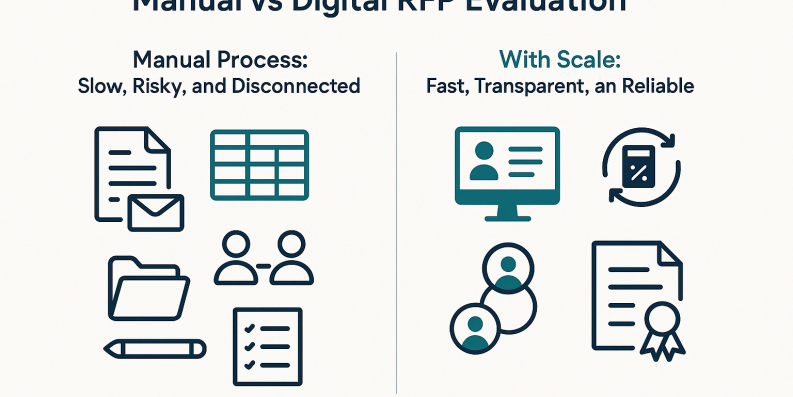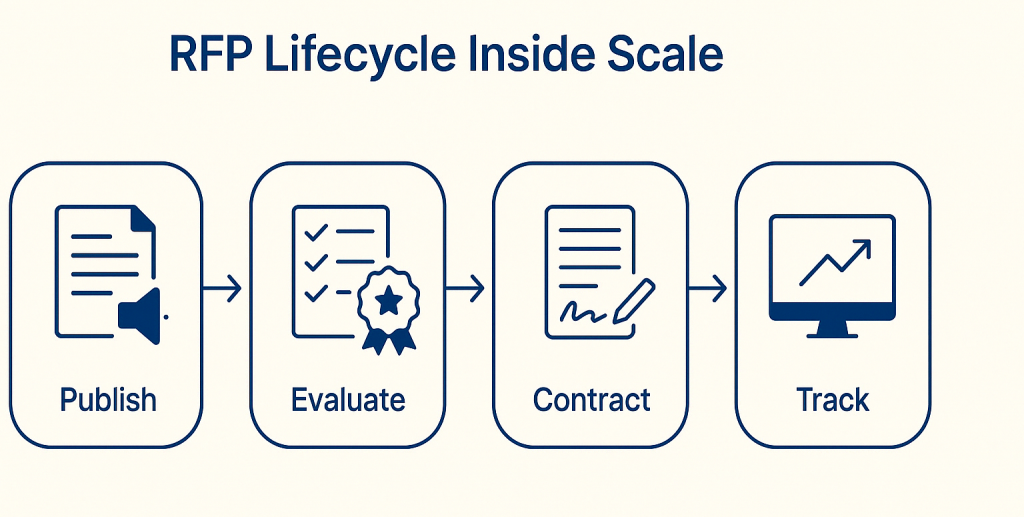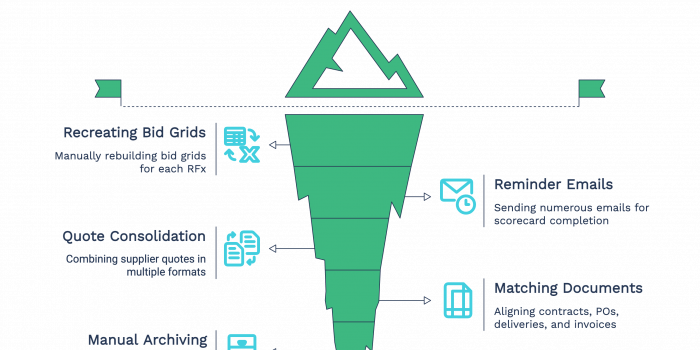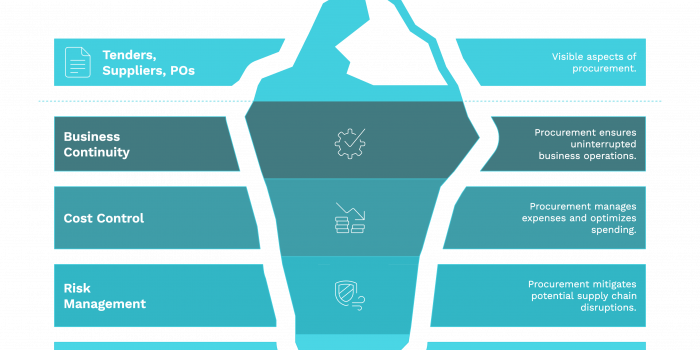RFP Evaluations: Choosing the Right Method, Powering the Right Outcomes
When it comes to sourcing high-value goods or services, issuing a Request for Proposal (RFP) is just the beginning. The real work — and risk — lies in how you evaluate those proposals. Choose the wrong evaluation method, and you might end up with a flashy presentation but poor delivery.

When it comes to sourcing high-value goods or services, issuing a Request for Proposal (RFP) is just the beginning. The real work — and risk — lies in how you evaluate those proposals.
Choose the wrong evaluation method, and you might end up with a flashy presentation but poor delivery. Choose the right one, and you unlock long-term value, supplier reliability, and peace of mind.
At Scale, we don’t just help you publish RFPs. We help you evaluate smarter and contract faster.

Understanding RFP Evaluation Types
Each RFP is different — and so is the best way to evaluate it. Here’s a breakdown of the most commonly used methods and when to use them:

1. Cost-Based Selection (CBS)
- Purpose: Select the lowest-priced bid that meets the minimum technical requirements.
- Use When: Procuring simple, standardized, or commodity goods/services.
- Weighting: 100% Financial
- ✅ Pros: Easy, fast, transparent
- ⚠️ Cons: Ignores quality and long-term value
2. Quality-Based Selection (QBS)
- Purpose: Choose the technically superior proposal; cost is evaluated later or fixed.
- Use When: Procuring consulting, design, research, or creative services.
- Weighting: 100% Technical
- ✅ Pros: Ensures quality, ideal for complex projects
- ⚠️ Cons: Can be costly if price isn’t capped
3. Combined Quality and Cost-Based (CQCB or QCBS)
- Purpose: Balance technical and financial scores using a weighted formula.
- Use When: Most public procurement and complex sourcing situations.
- Weighting Example: 80% Technical / 20% Financial
- ✅ Pros: Balanced, encourages competitive pricing + quality
- ⚠️ Cons: Requires thoughtful design of scoring criteria
4. Fixed Budget Selection (FBS)
- Purpose: Choose the highest-quality proposal within a predefined budget.
- Use When: Budget is rigid and non-negotiable (e.g., donor-funded projects).
- ✅ Pros: Eliminates price escalation
- ⚠️ Cons: May limit innovative solutions outside the budget range
5. Least Cost Selection (LCS)
- Purpose: Select the lowest-cost option among technically qualified bids.
- Use When: Evaluation requires minimal subjectivity (e.g., data entry, audits).
- ✅ Pros: Fast and highly objective
- ⚠️ Cons: May discourage high-quality providers
Why the Evaluation Method Matters
Your evaluation framework affects everything:
- The quality of suppliers you attract
- The fairness and transparency of your process
- The value you derive from the contract
- Your ability to justify decisions under audit
That’s why modern procurement teams use Scale to ensure accuracy, consistency, and compliance — from publishing to evaluation to contracting.
How Scale Transforms RFP Evaluations
We’ve reimagined the entire evaluation process — not just the tender notice. Here’s how Scale supports every stage of the RFP lifecycle:
1. Publish with Confidence
- Use pre-built RFP templates for different industries
- Add detailed scopes, evaluation criteria, and deadlines
- Target suppliers by category or invite specific ones
- Collect responses in a structured, comparable format
2. Evaluate with Intelligence
- Set up custom evaluation criteria (technical, financial, weighted)
- Invite internal and external evaluators with access controls
- Use smart auto-scoring and evaluator dashboards
- Attach supporting documents, comments, and scores digitally
- Maintain a full audit trail of decisions and changes
Evaluator Roles and Access
Managing your evaluation team can be complex — especially when different evaluators handle technical and financial components or when external reviewers are involved.
On Scale, you can:
- Assign evaluators to specific categories or criteria
- Control the visibility of financial proposals to prevent bias
- Set role-based access so evaluators only see what they need
- Track who scored what — and when — for full transparency
🔐 This keeps evaluations clean, unbiased, and audit-ready — a must for organizations that prioritize fairness and compliance.
3. Contract with Certainty
- Auto-generate evaluation reports instantly
- Notify selected bidders and issue contracts directly
- Store contracts securely and link them to supplier profiles
- Track performance against awarded contracts
Benefits of Using Scale for RFP Evaluation and Beyond
✅ Speed: No more manual scoring sheets or back-and-forth emails
✅ Transparency: Full visibility for stakeholders and auditors
✅ Compliance: Meets public and private sector evaluation standards
✅ Consistency: Standardized formats across departments or projects
✅ Data-Driven: Insights on supplier history, score trends, evaluator behavior
✅ Evaluator Control: Role-based access and clean segregation of duties
✅ Automatic Report Generation: Save time and improve documentation quality
✅ Seamless Transition: From evaluation → award → contracting → tracking
Publish Smart. Evaluate Smarter. Contract Confidently.
Evaluation is where the real value is won or lost in procurement. It’s not just about choosing a supplier — it’s about defending your choice, proving the value, and setting the stage for performance.
With Scale, you don’t just run RFPs — you run them better.
👉 Ready to streamline how you publish, evaluate, and contract?
Book a Demo Today →








